1st Chang’e-3 Lunar Panorama
Portion of 1st panorama around Chang’e-3 landing site showing China’s Yutu rover leaving tracks in the lunar soil as it drives across the Moon’s surface on Dec. 15, 2013. Images taken by Chang’e-3 lander following Dec. 14 touchdown. Panoramic view was created from screen shots of a news video assembled into a mosaic.
Credit: CNSA/CCTV/screenshot mosaics & processing by Marco Di Lorenzo/Ken Kremer
See below robotic arm screenshots – – Story updated [/caption]
As night fell on the Earth’s Moon, China’s Yutu rover and mothership lander have both entered a state of hibernation determined to survive the frigidly harsh lunar night upon the magnificently desolate gray plains.
Yutu went to sleep at 5:23 a.m. Dec. 26, Beijing time, upon a command sent by mission control at the Beijing Aerospace Control Center (BACC), according to China’s State Administration of Science, Technology and Industry for National Defence (SASTIND).
The Chang’e-3 lander began its long nap hours earlier at 11:00 a.m. Beijing time on Christmas Day, Dec. 25.
The vehicles must now endure the lunar night, which spans 14 Earth days in length, as well as the utterly low temperatures which plunge to below minus 180 degrees Celsius.
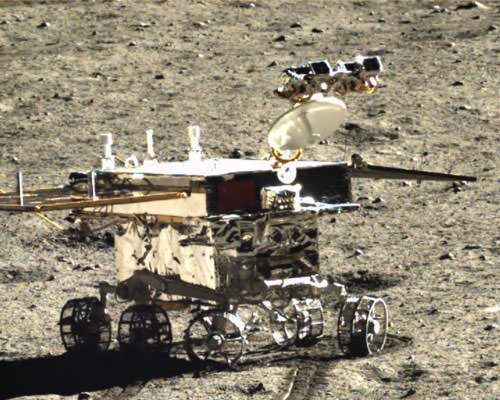
Scientists completed a series of engineering tests on the probes to ensure they were ready to withstand the steep temperature drop, said Wu Fenglei of the Beijing Aerospace Control Center, to the Xinhua state news agency.
Since there is no sunlight, the solar panels can’t provide any power and have been folded back.
So they face a massive engineering challenge to endure the extremely cold lunar night.
Therefore in order to survive the frigid lunar environment, a radioisotopic heat source is onboard to provide heat to safeguard the rovers and landers delicate computer and electronics subsystems via the thermal control system.
They are situated inside a warmed box below the deck that must be maintained at a minimum temperature of about minus 40 degrees Celsius to prevent debilitating damage.
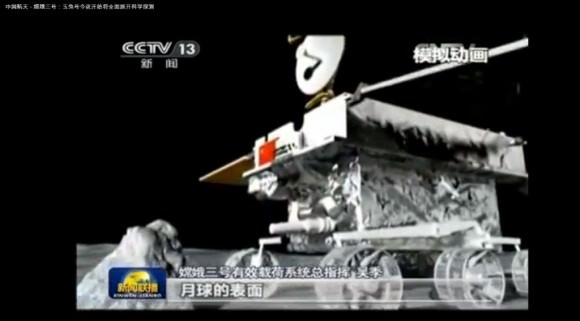
So the two spacecraft still have to prove they can hibernate and eventually emerge intact from the unforgiving lunar night.
Just prior to going to sleep, the 140 kg Yutu rover flexed its robotic arm and Chinese space engineers at BACC completed an initial assessment testing its joints and control mechanisms.
The short robotic arm appears similar in form and function to the one on NASA’s famous Spirit and Opportunity Mars rovers.
It is equipped with an alpha particle X-ray instrument (APXS) – on the terminus – to determine the composition of lunar rocks and soil.
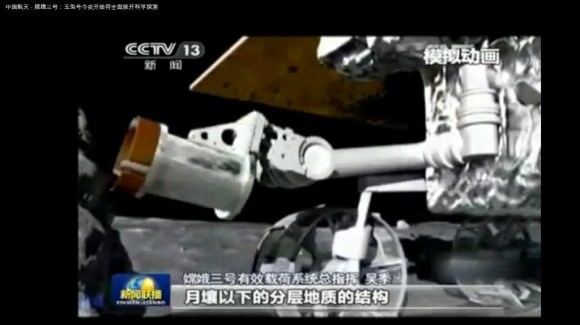
The robotic pair of spacecraft safely soft landed on the Moon on Dec. 14 at Mare Imbrium, nearby the Bay of Rainbows, or Sinus Iridum region. It is located in the upper left portion of the moon as seen from Earth. You can easily see the landing site with your own eyes.
Barely seven hours after the history making touchdown, ‘Yutu’ was painstakingly lowered from its perch atop the lander and then successfully drove all six wheels onto the moon’s surface on Dec. 15.
Yutu left noticeable tracks behind, several centimeters deep, as the wheels cut into the loose lunar regolith.
The Chang’e-3 lander and rover then conducted an initial survey of the stark lunar landing site, pockmarked with craters and small boulders.
They took an initial pair of portraits of one another. Read my earlier report – here.
The four legged lunar lander also snapped the missions first panoramic view of the touchdown spot at Mare Imbrium using three panoramic cameras (Pancams) pointing in different directions. Read my earlier report – here.
See the eerie panoramic view of the landing site showing Yutu’s first moments on the alien lunar surface in our screenshot mosaic above – and here.
See the dramatic video with an astronauts eye view of the lunar descent and touchdown in my prior story – here.
Yutu, which translates as ‘Jade Rabbit’, was then directed to travel in a semicircular path around the right side of the lander and is heading to the south.
Its currently napping about 40 meters to the south.
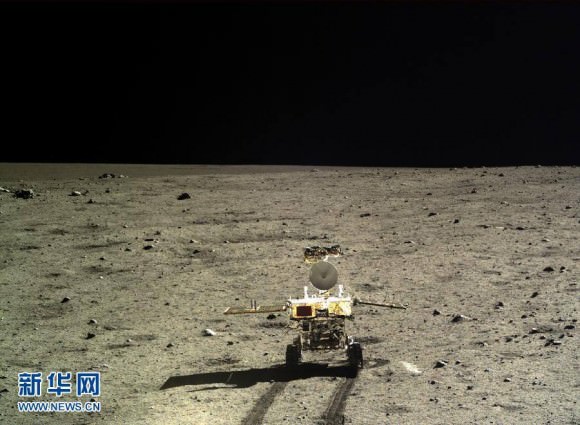
‘Jade Rabbit’ will resume the lunar trek upon awakening, along with the stationary lander, from their extended two week slumber around Jan 12, 2014.
Yutu will depart the Chang’e-3 landing zone forever and rove the moon’s surface for investigations expected to last at least 3 months – and perhaps longer depending on its robustness in the unforgiving space environment.
The robotic rover will use its suite of four science instruments to survey the moon’s geological structure and composition to locate the moon’s natural resources for use by potential future Chinese astronauts, perhaps a decade from now.
NASA’s Lunar Reconnaissance Orbiter (LRO) imaged the Chang’e-3 landing site in western Mare Imbrium around Christmas time on 24 and 25 December with its high resolution LROC camera and we’ll feature them here when available.
China is only the 3rd country in the world to successfully soft land a spacecraft on Earth’s nearest neighbor after the United States and the Soviet Union.
The best is surely yet to come!
Stay tuned here for Ken’s continuing Chang’e-3, LADEE, MAVEN, MOM, Mars rover and more news.

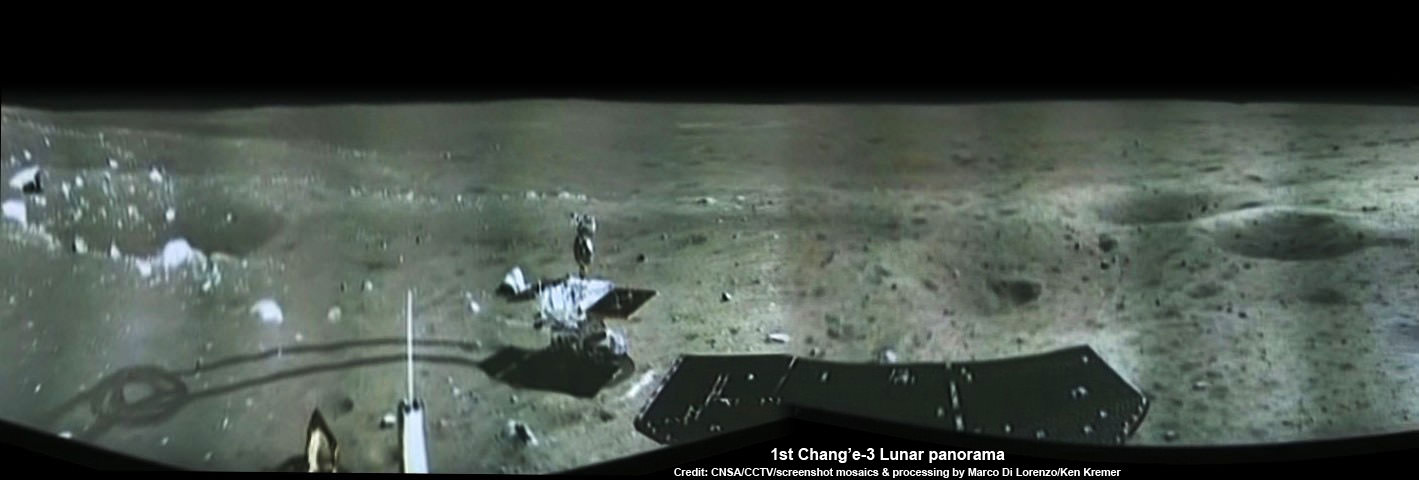
Great job little one, Have a nice sleep then send us back some more pictures in January, So far so good, Keep it going this is great PR work for China well done, your the only ones on the block………….
I hope it survives.
So the RTG is on board the rover, not the stationary lander? Still, it has solar panels too. I love the last image: Off you go, good luck!
Actually, it’s a radioisotope heater unit (RHU), not an RTG; the Chang’e 3 lander is also equipped with an RHU as is the rover.
Because only at the moon does a lander stay 14 days in the night, it needs a heater to keep the electronics healthy. Since there is no sunlight for 14 days, it cannot use the solar panels.
No other orbiter or lander out there gets in this unique situation that it stays in the shadow for 14 days.
Yutu looks so cute heading off into the wilderness, again well done China Great Stuff.
Been wondering why one solar panel is/was lower than the other… “Since there is no sunlight, the solar panels can’t provide any power and have been folded back.” It will be interesting to see when the solar panels redeploy if they are in the same horizontal orientation, as one panel was definitely lower than the other when ‘Jade Rabbit’ left the lander (Image 5). I assumed this was intentional and have not heard otherwise, yet wonder after it. I note here the third image (CGI) shows the solar panels being parallel.
The second image above shows the rover peering at the surface after making a ‘pirouette’. This image is new to me though apparently made prior to leaving on it’s lonely sojourn. Are the Chinese ‘trickling’ out the data?
Regardless… I’ll bet you a bushel of beans every transmission is being VERY carefully monitored by any and/or all.
P.S. As usual, thanks for being there for us on the weekends (AND holidays) Ken!
I’m sure there are good engineering reasons for the positioning of the solar panels
Yes, the Chinese are dribbling out the data as I wrote in an earlier story. I also requested that they establish a mission website like NASA does. So far no response.
But the China Space Facebook page did feature our screenshot mosaic here:
https://www.facebook.com/photo.php?fbid=648544721873199&set=a.642088965852108.1073741885.237730352954640&type=1&theater
The Moon looks more colorful, brownish, in the photos from Yutu than most photos from Apollo. Is it because of 40 years newer cameras? Do these images represent how it would look to the human eye on site, or do they have filters or something? The very white stones I assume are just reflexions.
there are Apollo pictures which show the lunar soil as more brown in color. this is primarily due to the incident angle of the sunlight, though the camera’s settings could need calibrating, as well. it’s difficult to say since we don’t have any of the raw data to look at.
It’s sad that China is also tampering with the moon photos. There is no dark place on earth that doesn’t have a massive star field in the sky on a clear night, yet the Yutu’s photos show a totally black empty sky. This is absolutely impossible! There is something in the distant landscape that they don’t want us to see. People need to start demanding that they stop hiding the truth about what’s on the moon!
Dude, I was going to delete your comment, which was held up in moderation, because your comment regurgitates the same old asinine argument from conspiracy cranks that has been debunked by many professional photographers. However, if I did so, you would accuse Universe Today of censorship, so I feel compelled to tell you this…
Perhaps if you were to venture out of your mom’s basement once in a while and go to a floodlit football/baseball stadium, when there’s a game on, with some buddies on a clear night, you’ll see when you look up at the sky that the glare from the stadium lights makes it impossible to see all but the brightest of objects – the Moon, Venus, and Sirius – and the sky will appear pitch black. This is because your eyes adjust to the brightness of foreground objects, and it’s the same case with film/digital cameras – try it and see for yourself! Most hoax supporters never bother. They are too bloody lazy!
Excellent, easily understood and readily exercised answer to the perennial “no stars in the sky” conundrum. I’m glad you chose to respond as opposed to delete.
Thanks! It just needed saying.
I suggest you look into taking Astronomy 101 at a local Junior College or at a local high school? OR maybe take a photography class at the same? OR consider attending a star party given by a local astronomy club? You will find that those parties are usually planned for a time closest to the new moon, when the sky is at it’s darkest.
no stars are captured because starlight is very faint. for cameras to capture starlight, exposure times of several seconds are needed. since the lunar surface is comparatively very bright, images of the surface with exposure times of several seconds would be badly overexposed and washed out. as an example, typical exposure times for images taken on the Apollo missions were 1/125th of a second – far too short a time to capture starlight.
you’ll be happy to know, though, that the lander does contain a telescope that is meant to observe the stars.
If the Chinese are dribbling out the data, that is sad. And certainly not good for publicising what is an impressive achievement. Probably explains whey a lot of people I talk to don’t even know of the existence of this mission. While they are certainly communicating with their machine on the Moon, they seem to have a lot to learn about communicating with other people on Earth.